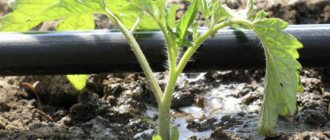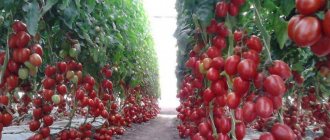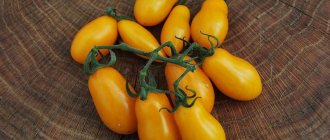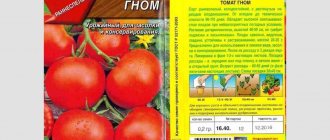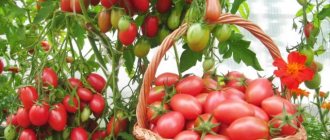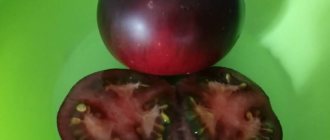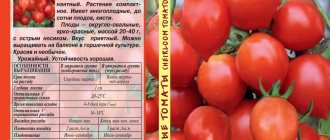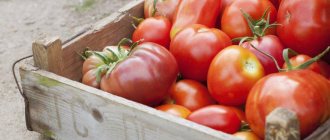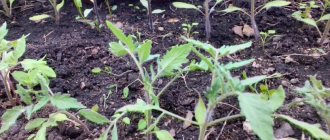general information
Since the market is full of bags of “dates,” people naturally buy them. Moreover, the sown seeds and grown plants of some produce good yields of tasty and sweet tomatoes, which are quite satisfactory for vegetable growers, while others leave much to be desired.
Perhaps someday they will conduct variety tests and enter such a “miracle” into the register, but for now we will be content with what “traditional craftsmen” have produced in the field of seed packaging.
Landing
Seeds are sown in boxes and containers from the end of March. At the end of May, the seedlings are transplanted to a permanent location.
The containers are covered with film before germination (for 7–8 days before germination), and opened slightly for 1–2 minutes for ventilation. If there is a lack of light, turn on the phytolights to provide additional illumination so that the seedlings do not stretch out. Fertilize 2 times, use nitrogen mixtures and complexes.
The soil mixture is selected to be light, with a neutral pH, and fertile. Components:
- garden turf;
- peat;
- compost;
- sand.
The seeds are sown to a depth of 1 cm, lightly sprinkled and compacted. Sowing time is mid-March. In mid-May, the bushes are transplanted into greenhouse shelters, and from the end of the month - into uncovered areas.
Description of the series
If we consider all the possible options for date tomatoes on the market, we can find common features for the entire series:
- Small fruit (up to 50 g);
- Oval, ovoid or obovate shape;
- Abundance of fruits;
- Semi-determinate or indeterminate vegetative form.
Grown tomato-date bushes, if you are lucky enough to become the owner of good seeds, can amaze and delight the vegetable grower with the beauty of their bush. Red and yellow candle tomatoes hang in clusters from sparsely leafed bushes.
These tomatoes are also good in a can. Vegetable growers who love exotic things and know a lot about cooking are constantly looking for interesting forms, and in this regard, dates are quite appropriate.
These varieties are also popular in Europe. Although they are not called dates, small, oval, cocktail tomatoes are present in any meal.
A vegetable plate with colorful tomatoes can decorate any table. Having selected very small tomatoes, you can combine them with olives, which also looks interesting.
Children really like these small tomatoes, both raw and canned.
Features of cultivation
Sowing the seeds of this variety of tomatoes for seedlings is carried out 60-65 days before the intended planting in the ground.
If you have grown Red Date tomatoes, please leave feedback about them in the comments. Write briefly the advantages and disadvantages of this tomato in your opinion. If possible, attach to your review a photo of the entire bush or individual fruits you grew. Thank you!
Your reviews of the Red Date tomato and additions to the description will help many gardeners evaluate this variety more objectively and decide whether it is worth planting or not.
"Date red"
Vegetable growers liked the small-fruited red tomato.
Characteristics and description
, which brought this “date” to the market describes the hybrid as semi-determinate. However, the red date tomato f1 is listed in reviews as tall, indeterminate, reaching heights of 180 or even more centimeters. Some, when describing these tomatoes, compare them with an octopus tomato.
When describing the form, it should be said that it is not unambiguous. One bush, and even one tomato bunch can bear fruits of a round classic shape, oval, ovoid and obovate. This feature does not upset vegetable growers at all, since they are easy to calibrate according to their shape.
The size of the tomatoes is also not uniform. At the time of ripening, one tomato can weigh 15 g, another 7-8 g. But in color they will all be of a uniform, scarlet, rich color.
When cut, two nests with small seeds are clearly visible. The seed nests are not filled with pulp, and the juice is almost clear.
The skin of the fruit is very delicate, thin, but at the same time strong and well keeps the pulp from cracking. The fruits also respond very well to temperature treatments and do not crack under the influence of boiling water.
Tomato fruits are collected in brushes. Harvesting can be done with brushes, since ripening occurs evenly, and all fruits have approximately the same degree of ripeness.
The taste of tomatoes deserves special praise. The fruits are sweet, rich tomato taste and pleasant tomato aroma.
Advantages and disadvantages
Among the advantages, vegetable growers identified the following:
- high productivity;
- good disease resistance;
- excellent taste;
- good keeping quality;
- The shape of the fruit is interesting.
The disadvantage of the variety can be considered mis-grading. However, this is most likely a human factor rather than a property of the variety.
Tomatoes: advantages and disadvantages
The main advantages of Date Red F 1:
- Refined exterior and taste of fruits;
- Immunity to specialized diseases;
- Universal cultivation;
- Various applications;
- Unpretentiousness.
The hybrid also has some disadvantages:
- Inability to grow from your own seeds;
- Relatively late maturation;
- Not the highest yield;
- Dependence of yield on stable warm weather.
"Date yellow"
Oval yellow tomatoes are beautiful on the bush and on the plate.
Description of the variety
The Yellow Date tomato has a semi-determinate bush. Plant of mid-late ripening period. The foliage is weak, and the leaf blade itself is small and light green.
The fruits are not large, equal in size and shape. Oval small cream weighs up to 20 g. Tomatoes are tied in simple sour, 6-8 pieces each.
When cut, two nests filled with rich pulp are visible.
The taste of tomatoes is very rich, sweet, without being cloying.
Advantages and disadvantages
Tomato is very popular among vegetable growers. Among its advantages:
- Productivity;
- Interesting taste with sweetness;
- Disease resistance.
Vegetable growers note the late ripening of fruits as a disadvantage.
Resistance to diseases and pests
Tomato is very disease resistant. There is not a single review that says that his tomato bushes were “attacked” by late blight or bacterial diseases.
The yellow date is insensitive to changes in temperature and environmental humidity and bears fruit well.
Features of growing the variety
There are no particular difficulties in growing this “date”. Like all semi-derminant varieties, it needs support and tying.
The formation of shoots is carried out in 2-3.
Planting seedlings in the ground
Prepare the soil in the fall. For 1 m² of clay or loam, scatter 3 buckets of soil mixed from equal parts of peat, humus and sawdust. If you have peat, then per 1 m² pour 3 buckets of a composition of 2 parts humus, 2 parts turf, 2 parts sawdust and 1 part sand, a teaspoon of double superphosphate and 2 tbsp. spoons of ash. Dig up the soil, pulling out weeds and digging up roots.
At the end of May or at the beginning of June, plant the seedlings in a permanent place. Dig holes so that when planting seedlings, place 3 plants per 1 m². Pour hot water into the holes, then drive in the stakes, then place the seedlings and cover with soil. Next, tie up the bushes. Seedlings need an air temperature of +20 - 22 °C during the day, and at night - not lower than 18 °C.
The variety loves moisture, water it with warm, settled water in the evening. Watering is especially important before the buds open, during flowering and fruiting. Loosen the soil after watering very carefully so as not to damage the root system.
Water at least 2 times every 14 days, adding diluted mullein or bird droppings to the water. Instead of organic matter, you can add complex mineral fertilizers.
After the ovaries form, stop feeding with nitrogen. Throw up the bushes. You can leave 1 - 2 stepsons from the bottom of the bush, ovaries will appear on them. Start collecting fruits on July 15, when the tomatoes become technically ripe, since tomatoes ripen easily during storage.
See also
Description of the method of picking tomatoes according to GanichkinaRead
"Siberian date"
What variety of tomatoes was so named remains a mystery, but the Siberian Date tomato f1 leaves positive reviews if it is from.
Characteristics and description
This tomato has a determinate bush. Ripening begins quickly - the tomato is early ripening. In the garden, the height of the bush will be within 60-70 cm, but in a limited space it will not stretch above 50 cm. The tomato shoot is elastic, dense, it holds a large number of fruits well.
Tomatoes weigh about 20 grams. They ripen together, and the bush is quickly covered with plum-shaped tomatoes. If the vegetable grower does not have time to harvest the crop, he may well hang on the bushes until the tomatoes are harvested. The shoots hold the crop tightly, and sometimes it is necessary to pick it off with the stalk and whole bunches.
Reviews about the taste of the fruit indicate that the sugar content in tomatoes is very high, and the balance of organic acids combines very organically with sugars.
The wonderful sugar content is also reflected in the taste of tomatoes that were preserved in marinades. Such tomatoes are dense, tasty, sweet and without cracks.
Advantages and disadvantages
The Siberian Date tomato has a number of advantages:
- early maturation;
- high productivity;
- excellent taste properties;
- amicable maturation;
- good keeping quality of fruits;
- universal use;
- ability to grow in limited space.
Features of growing the variety
Experienced vegetable growers, knowing that early ripening tomatoes do not grow their seedlings, but sow them directly into tubs. If the seeds germinate well, then the seedlings are thinned out at the stage of two true leaves. The excess is planted in the garden, and some is left in a tub. Leaving 25-30 cm between the plants, after a while they close together and form a beautiful composition.
The main concern when growing “Siberian Date” comes down to:
- fertilizing;
- watering;
- loosening the soil;
- mulching if necessary.
Gardeners' opinion
Good afternoon The summer season was a success thanks to the Superbomb tomato. I planted it for the first time, the results exceeded expectations. The variety fully justified the positive reviews from its neighbor. From one bush we managed to collect about 7 kg of crop per season. The beautiful appearance of the fruit matches the contents. The berries were very large, sweet, fleshy. I didn’t find any disadvantages for myself.
Grigory Vasilievich, 54 years old.
I recommend the Superbomb variety to all lovers of large and sweet tomatoes. I have quite a bit of experience; I have personally grown 15 other varieties of tomatoes. This one stands out positively among its peers. To get the result as in the picture you will have to work hard. The plant loves abundant watering and regular feeding. The work will be justified by large and juicy tomatoes. The summer of weeding and loosening was not in vain; the tomato harvest was 6 kg.
Irina Abdurakhmanova, 58 years old.
The superbomb tomato variety is very much for everyone. The fruit is quite large in size - not suitable for canning. I couldn’t grow tomatoes like in the picture. Summer failed, and the plant was attacked by parasites. The harvest was not high. Next time I will definitely treat it with an insecticide and try to feed it more.
Lyudmila Ivina, 43 years old.
"Sweet date"
Since there are no date varieties in the register, experienced businessmen solve the problem in their own way. This is not always a bad thing, but vegetable growers get confused about varieties and hybrids.
Vegetable growers, growing the “Sweet Date” tomato, the description of which completely coincides with the “Cherriliza F1” hybrid, came to the conclusion that this is the brainchild of Moscow, Russia.
The hybrid was entered into the register in 2010 and recommended for growing under film covers.
Characteristics and description
The tomato has a salad purpose and is also suitable for whole-fruit canning. Early ripening, it quickly produces an intermediate type inflorescence and bears wonderful fruits.
The plant is tall and indeterminate. The leaf is dark green in color and completely small.
The fruits are cylindrical, smooth, dense, elastic, bright orange in color. The weight of one fruit is from 8 to 10 g. The fruits are identical, equal in length and width. Each brush bears 18-20 fruitlets, which look lovely.
Reviews
I grow this variety every year in polycarbonate greenhouses. I like its sweet taste. Salting with them turns out good. The tomatoes are small, the skin is elastic and does not burst. The variety bears fruit even in the first frost.
I like to plant this variety on my site, as it is completely unpretentious. I grow it through seedlings, then transplant it into the ground. Good yield and excellent dessert taste. Moreover, the fruits are stored at home for about 2 months, they ripen on their own and do not lose their sweetness.
The best of the small fruit varieties that I have planted. Firstly, it has a high yield for 3 months. I have enough for canning and eating fresh for another 1.5-2 months after harvesting. Secondly, tomatoes look beautiful in dishes and on the table, and have a sweet, sugary taste.
- Author: Maria Sukhorukikh
Rate this article:
- 5
- 4
- 3
- 2
- 1
(0 votes, average: 0 out of 5)
Share with your friends!
"Date orange"
Very similar to a sweet date, but unlike it, the “Orange Date” tomato is a late-ripening tomato.
Characteristics and description
The tomato is intended for cultivation both in film greenhouses and in open ground.
The variety is tall, indeterminate, carpal. One cluster bears up to 20 fruits, uniform in shape and size, weighing up to 20 g.
The fruits of this tomato are bright, rich, orange-amber in color, and oval in shape.
Taste characteristics are rated “excellent”. Balanced sugar and acidity, pleasant notes in taste and aroma, long aftertaste, all this makes the tomato desirable for growing again and again.
The core of the tomato fruit has no voids. The seeds are small, the skin is thin, but does not allow it to burst during bad weather and heat treatments.
Advantages and disadvantages
The variety is very good for growing, it has:
- excellent taste;
- beautiful colour;
- high productivity;
- excellent keeping quality of fruits;
The disadvantage can be called:
- late ripening;
- the need for formation;
- need for garters.
Resistance to diseases and pests
Tomato behaves very well in a greenhouse. But there is no specific data on the variety’s resistance to diseases in open ground.
To avoid damage to tomatoes during the growing season, it is better to apply a series of preventive sprays.
Using modern fungicidal preparations, you can easily prevent the spread of fungal infection. It is better to carry out the first spraying at the moment of formation of the initial ovary, and then at intervals of 15-20 days.
Experienced vegetable growers recommend changing 3-4 fungicidal preparations per season; this will not allow microscopic fungi and their spores to mutate and adapt to chemical preparations.
Bush care
Plants need to be tied to trellises or a greenhouse frame and partially pinched into 2 stems. When growing, special attention is paid to the feeding regime :
- The first, nitrogenous fertilizers, is carried out 14 days after planting;
- The second, with a solution of manure - 2 weeks after the first;
- Third, ammonium nitrate and superphosphate - 2 weeks after the second;
- Fourth, organic fertilizers - 2 weeks after the third.
